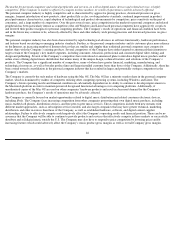Apple 2005 Annual Report Download - page 50
Download and view the complete annual report
Please find page 50 of the 2005 Apple annual report below. You can navigate through the pages in the report by either clicking on the pages listed below, or by using the keyword search tool below to find specific information within the annual report.
experienced increased demand for their products. The Company uses some components that are not common to the rest of the personal
computer industry including certain microprocessors and ASICs. Continued availability of these components may be affected if producers were
to decide to concentrate on the production of components other than those customized to meet the Company’s requirements. If the supply of a
key component were to be delayed or constrained on a new or existing product, the Company’s results of operations and financial condition
could be adversely affected.
The Company’s ability to produce and market competitive products is dependent on the ability and desire of IBM and Freescale
Semiconductor, Inc. (Freescale) to supply PowerPC microprocessors and Intel to supply its microprocessors for the Company’s Macintosh
computers and to provide the Company with a sufficient supply of microprocessors with price/performance features that compare favorably to
those supplied to the Company’s competitors. While the Company has supply agreements with IBM and Freescale, the Company’s recent
announcement of plans to transition to Intel microprocessors may impact the continued availability on acceptable terms of certain components
and services, including PowerPC G4 and G5 microprocessors, which are essential to the Company’s business and are currently obtained by the
Company from sole or limited sources. Additionally, there have been instances in recent years where the inability of the Company’s suppliers
to provide advanced PowerPC microprocessors in sufficient quantity has had significant adverse effects on the Company’s results of
operations. In addition, IBM is currently the Company’s sole supplier of the PowerPC G5 processor, which is used in the Company’s current
Power Mac, Xserve, and iMac G5 products. Freescale is the sole supplier of the G4 processor, which is used in the Company’s eMac, Mac
mini, and portable products. IBM experienced manufacturing problems with the PowerPC G5 processor, which resulted in the Company
delaying the shipment of various products and constrained certain product shipments during the second half of 2004 and the first quarter of
2005. Manufacturing problems experienced by any of the Company’s suppliers in the future or failure by them to deliver components to the
Company in sufficient quantities with competitive price/performance features could adversely affect the Company’s results of operations and
financial condition.
The Company must successfully manage frequent product introductions and transitions to remain competitive and effectively stimulate
customer demand.
Due to the highly volatile and competitive nature of the personal computer and consumer electronics industries, which are characterized by
dynamic customer demand patterns and rapid technological advances, the Company must continually introduce new products and technologies,
enhance existing products in order to remain competitive, and effectively stimulate customer demand for new products and upgraded versions
of the Company’s existing products. The success of new product introductions is dependent on a number of factors, including market
acceptance; the Company’s ability to manage the risks associated with product transitions, including the transition to Intel-based Macintosh
computers, and production ramp issues; the availability of application software for new products; the effective management of inventory levels
in line with anticipated product demand, including anticipated demand for PowerPC-based and Intel-based Macintosh computers; the
availability of products in appropriate quantities to meet anticipated demand; and the risk that new products may have quality or other defects
in the early stages of introduction. Accordingly, the Company cannot determine in advance the ultimate effect that new products will have on
its sales or results of operations.
The Company’s products from time to time experience quality problems that can result in decreased net sales and operating profits.
The Company sells highly complex hardware and software products that can contain defects in design and manufacture. Sophisticated
operating system software and applications, such as those sold by the Company, often contain “bugs” that can unexpectedly interfere with the
operation of the software. Defects may also occur in components and products the Company purchases from third-parties. There can be no
assurance that the Company will be able to detect and fix all defects in the hardware and software it sells.
48
























